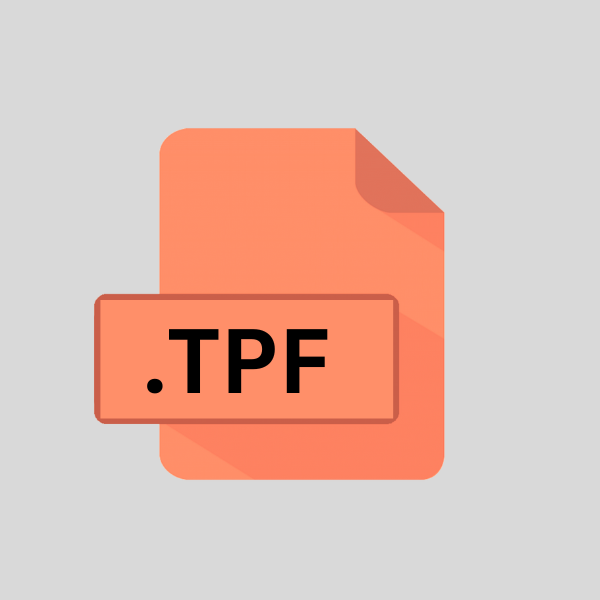.TPF File Extension

SPSS Text Wizard Document
| Developer | IBM |
| Popularity | |
| Category | Settings Files |
| Format | .TPF |
| Cross Platform | Update Soon |
What is an TPF file?
In the realm of data analysis and statistical computing, the .TPF file extension holds a significant position. This extension is associated with SPSS Text Wizard Document files, commonly used in the context of statistical analysis and data processing.
Understanding the nuances of .TPF files is crucial for researchers, analysts, and data scientists aiming to leverage the power of SPSS and similar statistical software.
More Information.
The .TPF file extension was introduced to facilitate the import and export of text data in SPSS. It was specifically designed to work with the SPSS Text Wizard, a tool within the SPSS software suite that enables users to import text data from various sources and convert it into a format suitable for statistical analysis.
Initially, .TPF files served the purpose of streamlining the process of importing and analyzing text-based data, allowing researchers to perform text analysis alongside traditional statistical methods.
Origin Of This File.
The origin of the .TPF file extension can be traced back to the development of SPSS (Statistical Package for the Social Sciences) software. SPSS, initially developed in the late 1960s, revolutionized the field of statistical analysis by providing a user-friendly interface for data manipulation and statistical modeling.
As SPSS evolved over the years to accommodate various data types and analysis techniques, the need for specialized file formats arose, leading to the emergence of the .TPF format.
File Structure Technical Specification.
At its core, a .TPF file is a structured document that contains text data along with metadata necessary for its interpretation within the SPSS environment.
The file structure typically includes headers, data fields, and formatting information, allowing SPSS to interpret and analyze the text data accurately.
From a technical perspective, .TPF files may adhere to specific formatting standards dictated by SPSS, ensuring compatibility and consistency across different versions of the software.
How to Convert the File?
Converting .TPF files to different formats can be necessary for compatibility with various software applications and operating systems. Below are general steps for converting .TPF files:
Open the .TPF File in SPSS:
- Launch IBM SPSS Statistics software on your computer.
- Navigate to the “File” menu and select “Open” to browse for the .TPF file you want to convert.
- Select the .TPF file and click “Open” to import it into SPSS.
Export the Data:
- Once the .TPF file is open in SPSS, you can manipulate and analyze the data as needed.
- After performing any necessary analysis or modifications, navigate to the “File” menu again.
- Choose the “Save As” or “Export” option to save the file in a different format.
Select Output Format:
In the save/export dialog box, choose the desired output format for conversion. Common formats for exporting data from SPSS include:
- CSV (Comma-Separated Values)
- Excel spreadsheet (.xls or .xlsx)
- Text file (.txt)
- SPSS Portable file (.sav)
Specify File Name and Location:
- Provide a name for the converted file and choose the location where you want to save it on your computer.
- Ensure that you remember the location for easy access later.
Adjust Export Options (if necessary):
- Depending on the chosen output format, you may have additional options to configure.
- For example, when exporting to CSV, you may need to specify delimiter settings or select specific variables to include.
Save and Convert:
- Once you’ve configured the export settings, click “Save” or “Export” to convert the .TPF file to the selected format.
- SPSS will process the data and save it in the specified format.
Verify Conversion:
- After conversion, navigate to the location where you saved the converted file.
- Open the file using the appropriate software application to verify that the conversion was successful.
- Ensure that the data is intact and formatted correctly in the new file format.
Additional Considerations:
- Depending on your specific needs and the compatibility requirements of the target software/application, you may need to perform additional steps or adjustments during the conversion process.
- It’s essential to review the documentation of both SPSS and the target software/application to ensure compatibility and optimal conversion results.
Advantages And Disadvantages.
Like any file format, the .TPF extension comes with its own set of advantages and disadvantages. One of the primary advantages of .TPF files is their seamless integration with SPSS, allowing users to import and analyze text data within the familiar SPSS environment.
.TPF files can preserve formatting and metadata, ensuring that the integrity of the original text data is maintained throughout the analysis process.
However, there are also limitations to consider when working with .TPF files. One such limitation is the dependency on SPSS software for data analysis.
While .TPF files are compatible with other statistical software through conversion, the full range of features and functionalities may not be available outside of the SPSS environment.
The proprietary nature of SPSS and .TPF files may pose challenges for users seeking interoperability with open-source or non-SPSS software solutions.
How to Open TPF?
Open In Windows
SPSS is primarily developed for Windows operating systems, making it straightforward to open .TPF files on Windows machines. Users can simply double-click on the .TPF file to launch SPSS and access the data within the software.
Open In Linux
While SPSS is not natively supported on Linux, users can utilize compatibility layers or virtualization software to run SPSS on Linux distributions. Alternatively, converting .TPF files to formats compatible with open-source statistical software like R or Python may be necessary for Linux users.
Open In MAC
Similar to Linux, SPSS is not officially supported on macOS. However, users can utilize virtualization software or emulators to run SPSS on Mac computers.
Alternatively, converting .TPF files to formats compatible with statistical software like IBM SPSS Statistics for Mac or other open-source alternatives is an option.
Open In Android
To open .TPF files on Android, install an SPSS file viewer app from the Google Play Store. These apps are specifically designed to handle .TPF files, allowing you to import and view data directly on your device.
Once installed, simply open the app, import the .TPF file, and access your data for analysis and interpretation on your Android device.
Open In IOS
To open .TPF files on iOS, download a compatible SPSS file viewer app from the App Store. These apps are tailored to handle .TPF files, enabling seamless import and viewing of data on iOS devices.
Open in Others
For other operating systems or specialized environments, converting .TPF files to universally compatible formats like CSV (Comma-Separated Values) or TXT (Plain Text) may be necessary. This allows users to import .TPF data into a wide range of software applications and platforms for analysis and visualization.












